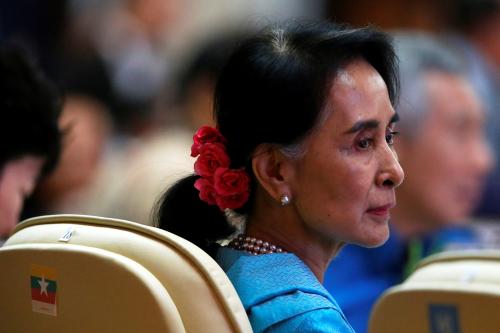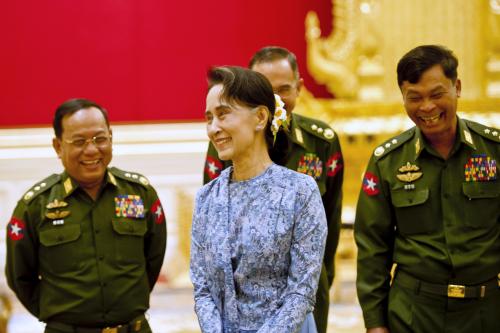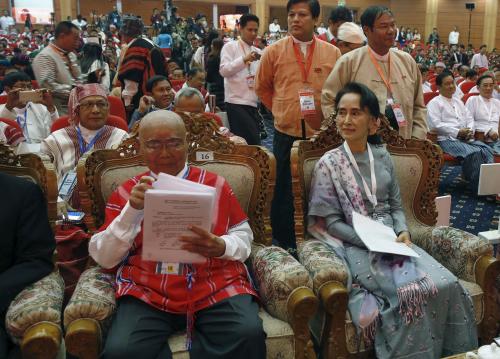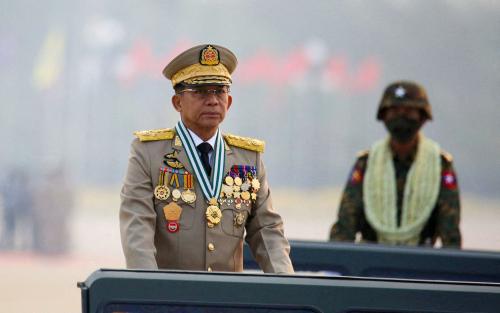This article originally appeared on the website of The Centre on Religion & Geopolitics (CRG), an international affairs think tank focused on the global interaction of religion, geopolitics, and conflict.
More than 140,000 people, mostly Muslim, have festered in squalid camps since clashes between Rakhine Buddhists and Rohingya and other Muslims in Myanmar’s western Rakhine state in 2012.
But the dire situation managed to take a turn for the worse in recent months. An insurgent Rohingya group known as Harakah al-Yaqin (HaY) attacked border guard police bases in northern Rakhine on 9 October, killing nine police officers. On 12 November, the group killed a senior army officer. These attacks were each followed by deadly reprisals from Myanmar’s security forces, which have been widely criticised as “indiscriminate,” “heavy-handed,” and “disproportionate.”
The United Nations estimates that about 30,000 people have been newly displaced in northern Rakhine State. Human Rights Watch says that since 9 October, at least 1,500 buildings have been burned. The head of the United Nations Refugee Agencyalso accuses the Myanmar military and border guard police of “killing men, shooting them, slaughtering children, raping women …forcing these people to cross the river” into Bangladesh. He asserts that the government has the “ultimate goal” of “ethnic cleansing of the Muslim minority in Myanmar.”
Myanmar has denied claims of atrocities. Journalists and aid workers are not allowed entry into northern Rakhine state making it difficult to establish facts on the ground. What is clear, however, is that the insurgency and subsequent government response mark an escalation in hostilities, and a qualitative change from the Buddhist-Muslim clashes that occurred in Rakhine in 2012 and periodically thereafter. Rohingya insurgents are targeting security forces who are responding in full force. While Buddhist villagers are feeling vulnerable — 3,000 in northern Rakhine State have reportedly fled to nearby towns — they have not been targeted.
The recent Rohingya insurgency and subsequent government response mark a qualitative change from earlier Buddhist-Muslim clashes in the border state.
HaY is said to have some international connections, namely, their leadership and funding, but their goals have thus far been local. According to the International Crisis Group (ICG), the leadership is headquartered in Mecca and is well connected in Bangladesh, Pakistan and possibly India. All have Rohingya roots. The ICG also underscores that the group has only attacked security forces, not religious targets, Buddhist villagers or civilians. HaY aims to “stop persecution of Rohingya and secure their rights and greater autonomy as Myanmar citizens.”
Why are recent developments worrying?
These recent developments are particularly concerning for at least two reasons.
First, they represent a hardening of Rohingya and government attitudes and are likely to lead to broader radicalisation and a spiral of violence. While radical Rohingya groups existed from the 1970s to 1990s, they never enjoyed much local support.
In the case of HaY, the ICG argues that it would not have been possible for the group to establish itself and prepare for the attacks without local buy-in. While local communities may simply have been looking the other way for fear of punishment — HaY reportedly killed two informants in September — indiscriminate force by security forces against an already despairing community will undoubtedly add to the numbers willing to accept violence as their only way out.
Second, collective punishment of the Rohingya for the acts of an insurgent group undermines broader societal ties. Rohingya and other Muslims are widely regarded in Myanmar as outsiders who are threatening. Even the term “Rohingya” is rejected as it is perceived as a claim to being one of the 135 indigenous groups in Myanmar. Rather than leading from the front in correcting problematic perceptions of the Rohingya and wider Muslim community, Myanmar’s government is legitimising negative perceptions.
What is being done?
Bowing to international pressure, Myanmar’s de facto leader, State Counselor Aung San Suu Kyi, recently undertook two initiatives to address the situation.
First, in August this year, an Advisory Commission on Rakhine State was established. The nine-member commission is led byformer Secretary-General of the United Nations Kofi Annan.
Some human rights experts highlight that the commission’s mandate was flawed from the outset given that it will operate in accordance with Myanmar’s 1982 Citizenship Law. The law requires applicants who are not members of one of the 135 officially recognised ethnic groups (the Rohingya are not a recognised group), and who did not apply for citizenship under an earlier citizenship act, to show pre-1948 proof of settlement to apply for naturalised citizenship. This is an onerous requirement for the poor and marginalised Rohingya. Naturalised citizenship, moreover, offers fewer protections than (full) citizenship.
Perhaps more problematically, the commission’s findings and recommendations are only due in late 2017 and can contribute little in the meantime to stop the heavy-handed security response, or alleviate the humanitarian catastrophe unfolding in camps and villages in Rakhine state. Moreover, it does not appear that the recommendations of the Inquiry Commission on Sectarian Violence in Rakhine State, established in 2012 under former president Thein Sein, were implemented or helped to improve the situation. The danger is that the 2016 Advisory Commission, like the commission before it, will fail to spur on real change.
Second, in mid-December, Aung San Suu Kyi set up a 13-member taskforce to investigate the clashes and the security forces’ response to it. The taskforce is chaired by Vice-President Myint Swe, who headed military intelligence under former junta leader Than Shwe. The taskforce is expected to complete a full report on 31 January 2017, but appears to already have determined that “[g]overnment authorities have followed the law and acted legally in their response to the attackers.”
What more can be done?
When asked about the crackdown against the Rohingya community, Aung San Suu Kyi accused the international community of “drumming up calls for … bigger fires of resentment [between the two communities].” She also urged the international community to give Myanmar “time and space for the Government’s efforts to bear fruit.”
Yet, there are some steps that should and must be taken immediately. These include ensuring that any response by security forces is proportionate, ensuring humanitarian access to affected areas, and allowing observers and the media access to help establish facts on the ground.
Some argue that Aung San Suu Kyi has kept her head down about the situation in Rakhine because it exposes the limits of her power. The military controls the key ministries, namely, border, defense and home affairs.
Whatever the case, her failure to do even fairly basic things which would require no cooperation from the military, such as visit the area, and stop what the ICG has called “repeated blanket government denials … [which] reinforce a climate of impunity for troops,” hurts the situation. Further, it sends the disturbing message that what is happening in Rakhine state is acceptable.
Beyond these immediate steps, a path to citizenship for the Rohingya must be expeditiously pursued. Aung San Suu Kyi’s government has restarted former president Thein Sein’s citizenship verification programme. It no longer requires listing of ethnicity (previously Rohingya refused to list their ethnicity as Bengali). But participation in the programme remains low due to a lack of transparency about what it does, and general distrust of successive governments.
Further, strategies for economic development and nation-building must be worked out and put in place. Fostering identity along national lines will first require creating opportunities for different race and religious groups to interact with one another, while feeling secure about their place in the nation. One way of doing this is to provide funding for Rakhine Buddhists and Rohingya Muslims to work on joint projects with future funding contingent on such cooperation. Creating interaction opportunities must ultimately mean ending the segregation of communities and putting in place mixed living, studying and work places. Greater interaction will help convert hearts and eventually change mindsets.
While development and nation-building efforts will take years if not decades to bear fruit, this is no reason for Myanmar not to take immediate steps to condemn indiscriminate violence, even if it stems from the state apparatus, and resolve the humanitarian crisis. The latest developments in northern Rakhine state hurt Myanmar’s regional and international standing. If violence spreads, it will also have wider domestic repercussions: it will be hugely destabilising and take the country backwards on its path to democracy. Many in the international community were quick to herald Aung San Suu Kyi a saint; some are equally eager now to brand her a sinner. She herself lays claim only to being a politician. The politician in her must recognise or be made to see that the fires of race and religious conflict that Myanmar’s government fails to control, and in some cases actively fans, threaten to engulf the country.










Commentary
Op-edThe changing face of conflict in Myanmar’s Rakhine State
December 28, 2016